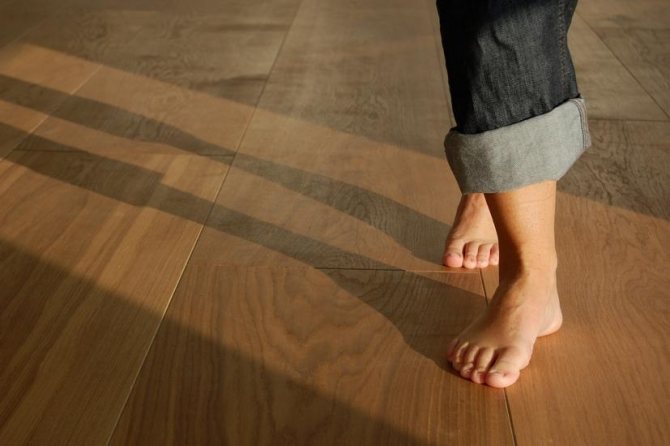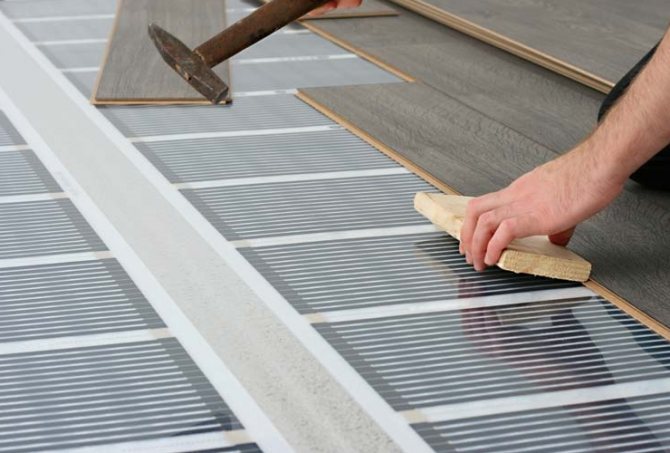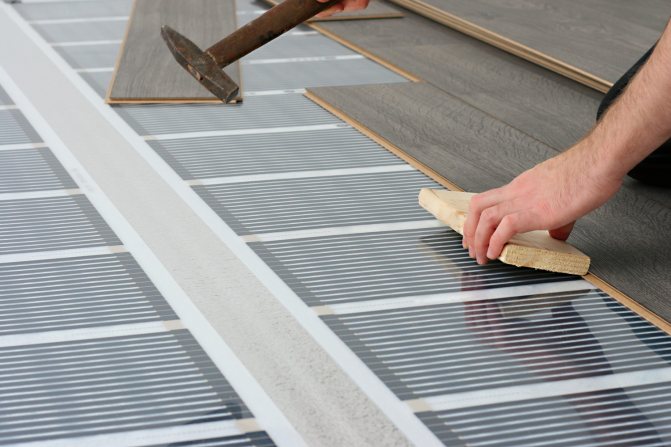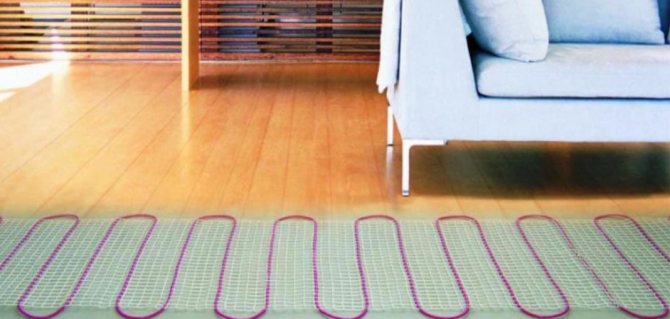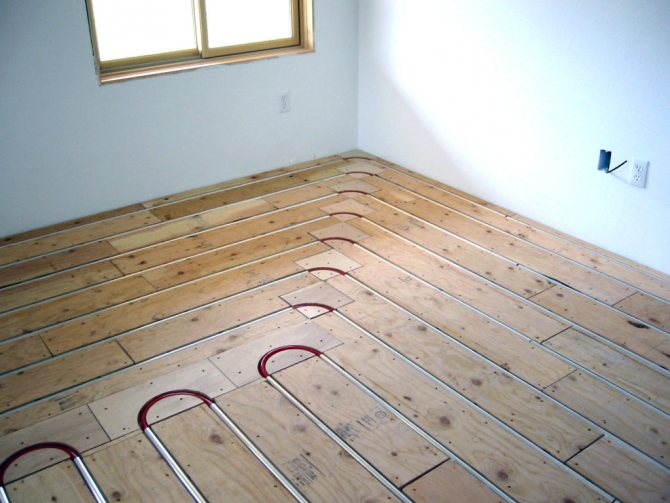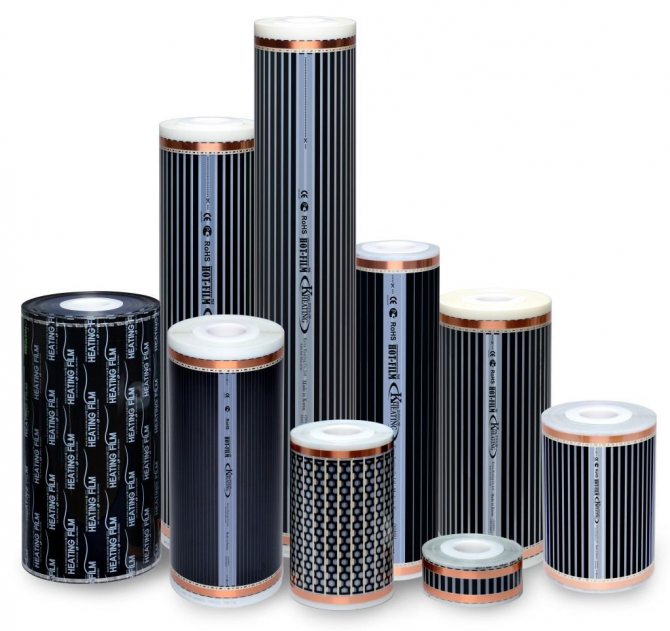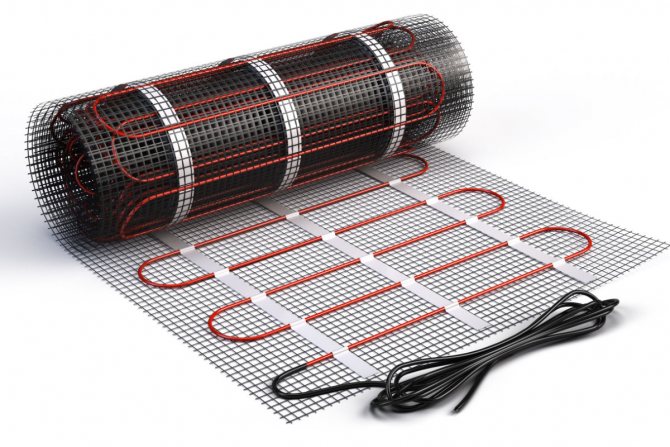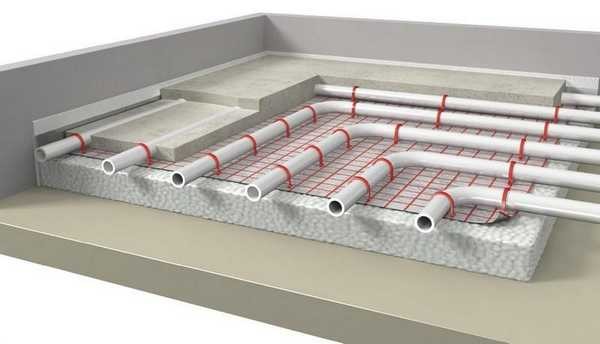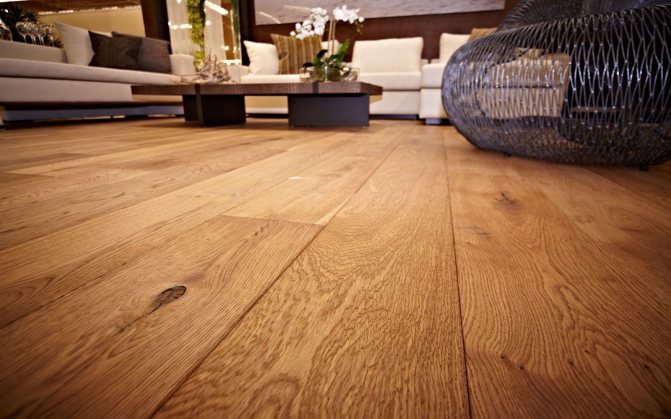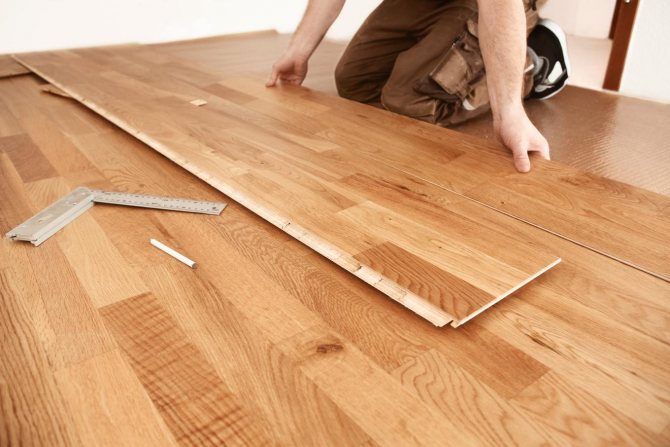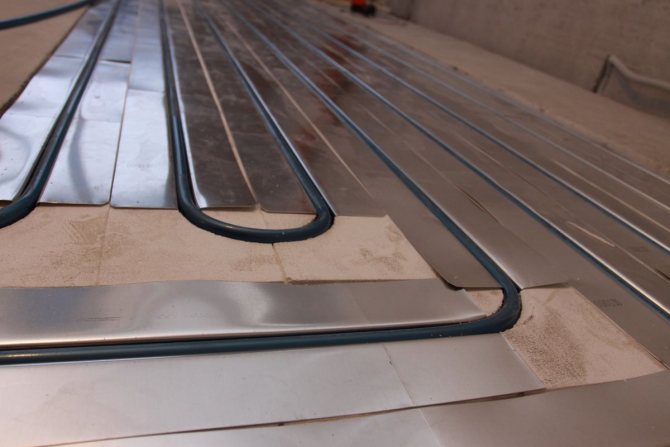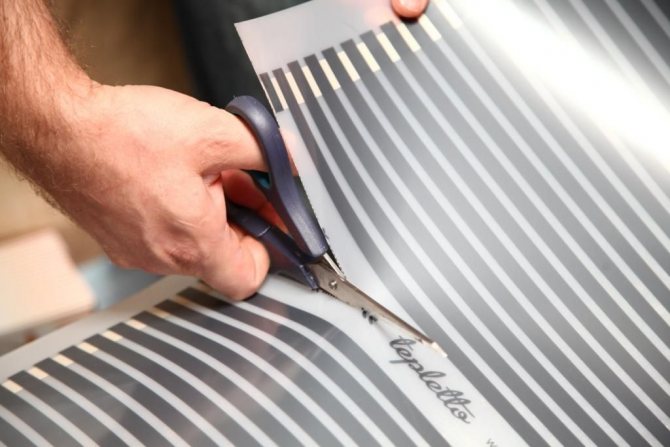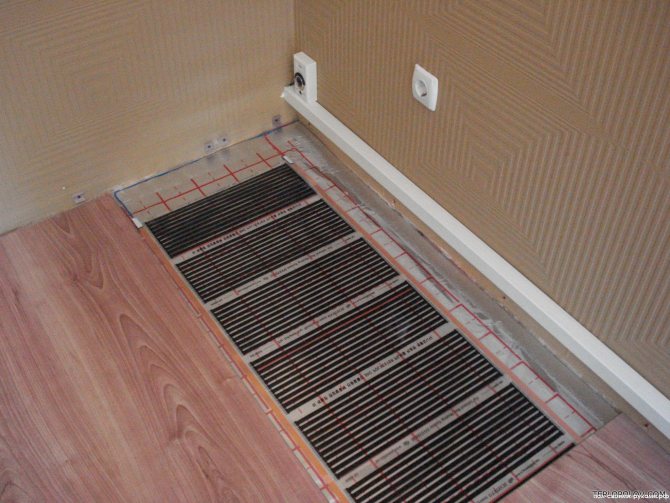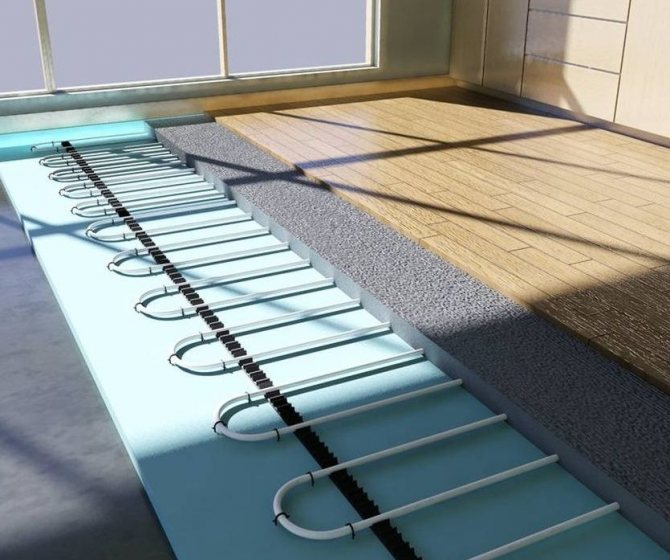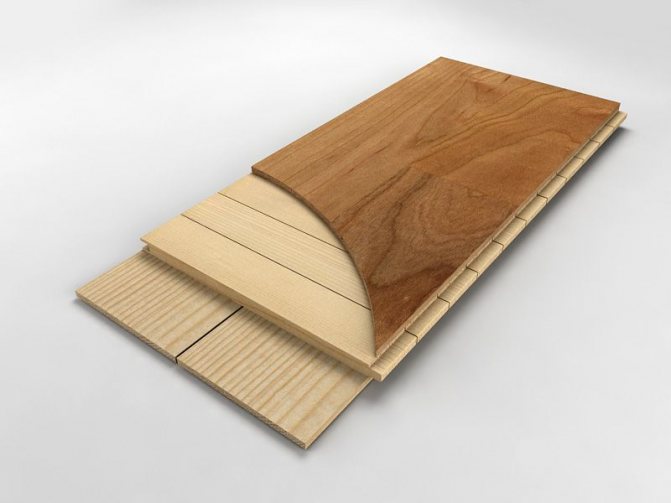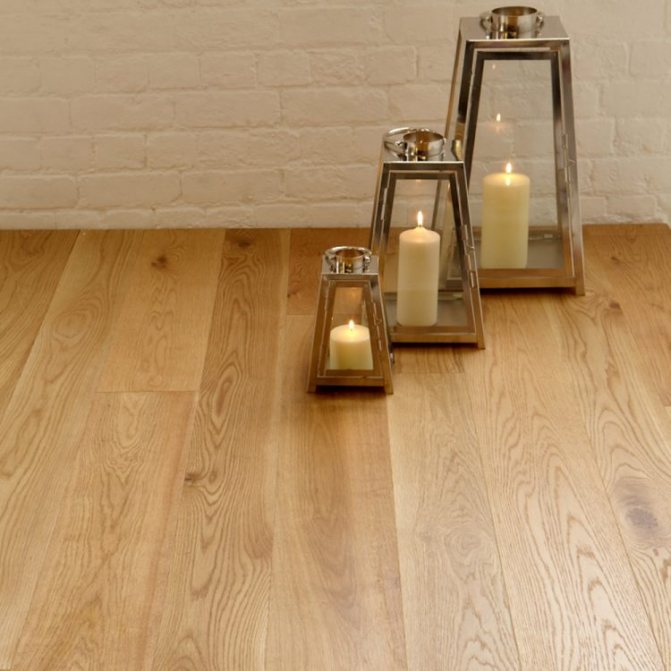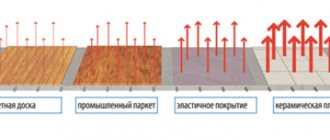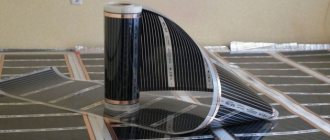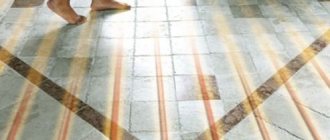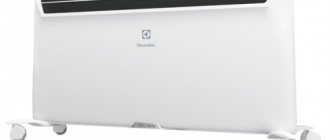The advantages of underfloor heating make this type of heating popular among individual home owners. Of great interest is the question of whether it is possible to use a warm floor under a parquet board, since many people want floors with a natural wood covering not only to please with a respectable appearance, but also to give warmth, contributing to the creation of comfortable living conditions.
Parquet board is a rather capricious material, so many factors should be taken into account when planning to equip a floor heating system under such a covering.

Types of suitable warm floors for parquet boards
Considering that the heating system gives an additional thermal load on the coating (in particular, parquet board), it is important to choose the most suitable type of warm floor. At the moment, there are 3 types of warm floors - infrared, electric and water - in order to choose the best option - we will consider each type separately
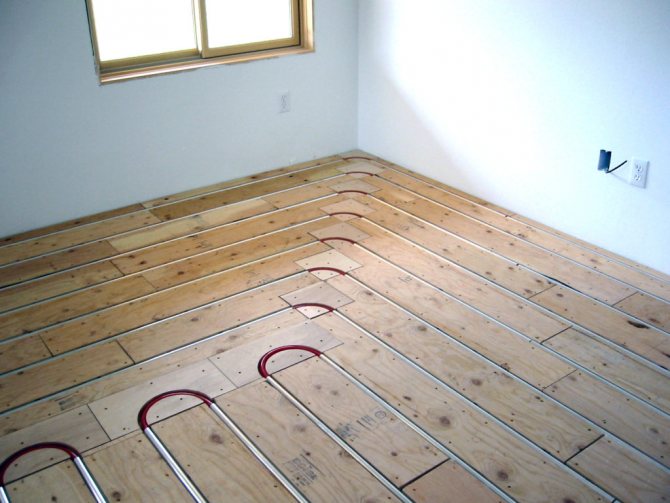

Infrared systems
Infrared heating systems consist of graphite elements embedded in a polymer film. When heated, the elements that make up the composition emit thermal energy in the infrared range, which is transferred to the parquet flooring. When using an infrared heating element in combination with a warm floor, it is undesirable to heat the coating over 28 degrees.
Electrical systems
Electric heating systems operate using heat cables. This heating system belongs to the most budgetary ones; the conductors, in combination with a wooden covering, increase the risk of fire. In this regard, a parquet board for a warm floor of this type is not recommended for use.
Water systems
Water heating systems consist of plastic pipes, inside of which there is water that is heated to the required temperature. This system evenly heats the floor and is completely safe, although it does not exclude the possibility of leaks. That is why parquet board for warm water floors is the ideal option.
What are the requirements for the installation of a warm floor under the board
In order for the system to work without affecting the flooring, in addition to choosing the right choice from the options presented, it is worth remembering that laying a parquet board in this case implies compliance with certain rules:
- A layer of plywood sheets must be laid under the coating with its reliable fixation with a concrete screed using two-component glue, self-tapping screws.
- A heat-insulating layer is arranged between the plywood substrate and the floor, which prevents premature wear of the coating;
- Think over the system in such a way that each coating die receives the same amount of heat.
Before the installation begins, complex calculations are carried out, not forgetting that the warm floor under the parquet must warm up to a certain temperature: the lower layer - up to 40 degrees Celsius, the upper one - up to no more than 27 degrees Celsius. It would be correct to entrust the installation to craftsmen who can achieve the ideal combination of underfloor heating with a heating system to reduce the number of pipes laid along the outer part of the floor.


Installation of any kind of warm floor is a serious task that requires special training.
Is it possible to put parquet or parquet board on the warm floor
We have explained why parquet, parquet board and solid floor board are not the most suitable types of flooring for a warm floor.Suitable - ceramic and stone tiles, acceptable - laminate, non-insulated linoleum and low-pile carpet. So after all, is it possible to put parquet or parquet board on the warm floor? We answer: it is impossible. But if you really want to, you can. You just need to understand that, firstly, this will negatively affect the efficiency of the heating system. Secondly, such a solution imposes a number of restrictions on both the functioning of the heating system and the selection and installation of wooden floors. More about this:
Features of the device of a warm floor under a natural wood covering
To prevent cracks from appearing in the parquet or parquet board during the heating season, the floor heating should not be strong. If we remember about formaldehyde, the warm floor under the parquet board should not be heated above 26 ºC. But that's not all. Manufacturers of solid parquet and parquet boards claim that in order to avoid deformation of the wood and to maintain its service life, the difference between the temperature of the coating and the air in the room should not exceed 2 ºC. If you adhere to the +18 ºC norm for residential premises, the floor should not be heated above 20 ºC. At this temperature, the floors will not feel cold, you can walk on them barefoot. But the heat generated by them is not enough to warm the room during the cold season. Of course, if we are talking about Central Russia, not Sochi. No, in a super insulated energy efficient passivehouse with forced recuperation ventilation and such a small amount of thermal energy will be enough for heating, but how many such buildings have we built? Therefore, in an ordinary house in a room with natural wood floors, the main heating devices should be radiators, and underfloor heating only complements them, only slightly heating the parquet.
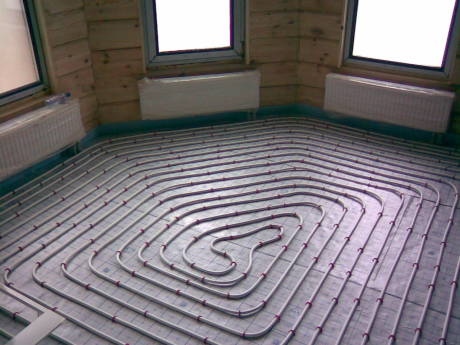

A standard mixing module for warm water floors will not be able to provide accurate and smooth temperature control at such low values and in a narrow range. You will need additional equipment: a floor temperature sensor (floor temperature, not room air) and a control valve servo.


And do not forget that wood does not transmit heat well from heating pipes, so the thickness of the heat-insulating layer must be increased from below so as not to waste energy and money in vain.
Features of the selection of parquet and plank flooring for underfloor heating
For a heated floor, you should select parquet and parquet boards made from the most stable types of wood. Oak, ash and walnut work best. The hornbeam behaves well. Exotic breeds other than teak and iroko are best avoided. Beech and maple are categorically not suitable, they are most susceptible to temperature and humidity expansion. It is advisable to use a larch floorboard.
You should choose a parquet board of average thickness - 13-17 mm. A thin 10mm one can warp, and a thick one will not let heat pass through well. It is better to choose parquet with a thickness of 16-18 mm, and a floorboard - 25 mm.


Features of installation of parquet flooring on a warm floor
If the above-mentioned temperature regime of floor heating is maintained, any type of wooden floor can be used as a covering: massive parquet and parquet board, glued multilayer parquet board, massive floor board. However, one should take into account the technology of installation of the coating:
The multilayer parquet board is laid in a "floating" manner on the substrate without fixing it to the base. There will be no problems with the accurate installation of such a floor, the recommended substrate thickness is 2-3 mm.
Solid parquet on a concrete screed should be laid on plywood, which, in turn, must be glued and fixed with dowels to the base. When laying the heating pipes, it is necessary to make a very accurate diagram of their location and, while drilling the holes in the screed for the dowels, take great care not to damage the pipe.


Parquet board under a water-heated floor
A heating water system is a structure made of plastic and metal pipes through which water moves, heated to the required temperature. The advantage of this model is that if it fails, the parquet will not light up, but if it leaks, the wooden boards may deform.
In addition, such a system is environmentally friendly and significantly saves energy costs. The disadvantages of the design include a significant rise in floors and the complexity of adjusting the temperature regime.
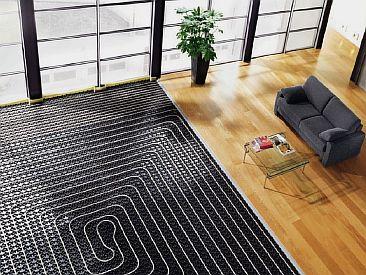

The most suitable for a water-heated floor is a parquet board with a moisture content of no more than 6 - 7%. It is desirable that the width of the plank is smaller. In addition, the product must be made of wood with increased resistance to deformation.
Rules for laying parquet on a water structure
The very process of installing a water system under parquet does not differ from laying this model of a warm floor under any floor covering. The only difference is in the preparation of the base for laying parquet boards.
The basic rules to be followed when equipping a parquet floor:
- When installing flooring, the air in the apartment should be as dry as possible, and a working fan is desirable.
- Installation of boards is carried out only in a "floating" way, this will minimize the process of compression and expansion of wood. The method is the adhesion of the boards to each other with metal staples, while they are not attached to the base. This method is also convenient because in the event of a breakdown, for repairs, there is no need to open the entire coating, you can dismantle the plates at the site of the system damage.
- After installing the parquet, the heating is switched on gradually, it should be added every day by 5 ° C.
Important! The heating system must be tested before installing the floor covering. Before installing the boards, the floor must have worked for at least 2 weeks. The day before installation, the system is switched to 18 ° C mode, or completely turned off.
Installation of parquet boards
Before installation, parquet boards should be stored in a dry room, horizontally. Before laying the covering, it is necessary to choose the direction of laying the boards. It is recommended to place the dies in accordance with the direction of daylight that falls into the room. In large rooms, the boards should be laid longitudinally, and in rooms with complex geometric shapes - diagonally.
In addition, you should prepare in advance the tool that you will need in your work - a saw, a hammer, a knife, a square, a drill, a chisel and tape measure, a heel, a spatula and a mounting foot.
The installation of a parquet board on a water floor itself looks like this:
- The area of the room is measured, and the number of rows is determined - we suggest using an online calculator. If there is not enough space for the last row to accommodate the board, it is necessary to cut the block of the front row.
- A thin layer of insulation is placed on the screed of the heating structure.
- Sheets of plywood are installed on the insulation as a flooring, since the peculiarity of laying parquet is the presence of a flat surface. They are mounted on self-tapping screws, this must be done carefully so as not to damage the heating elements. It is possible to fix the sheets with special glue.
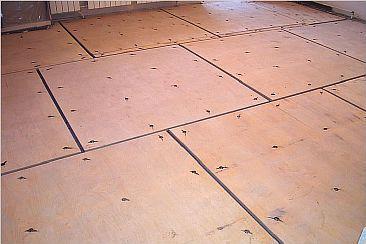

- The floor covering is laid from the wall, at a distance of at least 8 mm. In the future, these gaps will be covered with a plinth.
- Laying should start from left to right, from a solid wall. The gap of 10 mm between the tile and the wall is adjusted with wedges.
- The next product is applied with the small side to the installed element, and is attached by inserting the spike of one board into the groove of the other.
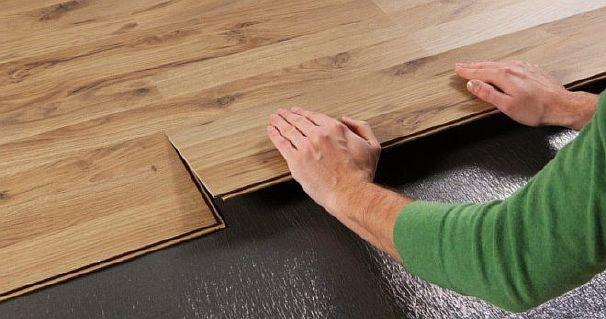

The whole parquet is laid according to this principle.
Choice of underfloor heating technology
Before laying a warm floor, you need to decide on its type. It is best to use an electric underfloor heating under the parquet, since in this case there is no danger of damaging the parquet board.If water heating is used, in the event of emergencies such as water leaks, the parquet floor can swell and deteriorate.
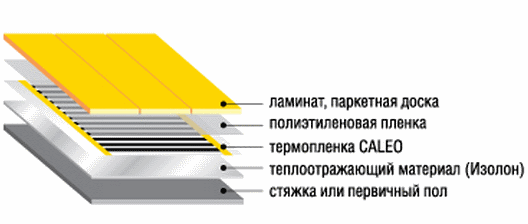

Diagram of the device for underfloor heating under parquet.
The work itself on laying the parquet board is quite lengthy, therefore, if there is a violation in the heating system, this coating will have to be removed, which is quite problematic.
It is also of great importance that the parquet board can be attributed to good insulation and if it is installed correctly, floor insulation may not be required. But still, if you install a warm floor under the parquet, then you need to remember that there must be a fireproof covering under it.
Stages of installing a warm electric floor
The most modern way to insulate a parquet board is with an electric cable. But in this case, there is 1 drawback - fire safety
Because of this, it is important to properly organize the insulation. At the first stage of work, the base is cleaned, all irregularities and debris are removed
For leveling, you can use a putty. Then a layer of waterproofing compound is applied. Support beams are installed on the base of the floor. They are made at a distance of 50-60 cm from each other. The surface between them is filled with waterproofing materials. Penofol or other sheet foam materials can be used.
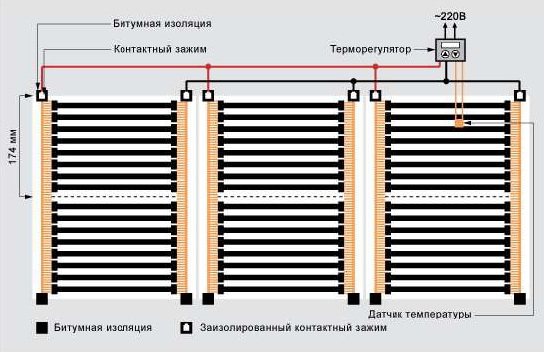

Installation diagram of an infrared film underfloor heating under a parquet board.
Roll materials such as mineral wool, for example, are also widely used. They need to be laid in strips. Fasten with special glue or make them overlap at least 10 cm. After that, you need to make a finishing floor. For this you need a parquet board. A galvanized mesh is placed on top. The electrical cable itself, in order to insulate the parquet board, is placed next to the beams at a distance of at least 1 cm from them. In the beams, cuts are made not for the entire thickness of about 3 cm wide, foil is laid, and an electric cable is laid on it. The cable is secured with mounting tape. A layer of non-combustible material will need to be made over the cable again. After that, it is necessary to organize the finishing floor. Warm floor under the board is ready. It is recommended to use plywood or wood-fiber materials (fiberboard) as a base for a parquet board, which are fastened with self-tapping screws. In this case, a sheet of plywood 50 x 50 cm must be fixed in 8 places.
The main disadvantages of parquet insulation
As already mentioned, it is not necessary to insulate a parquet board at all. Before doing this, you need to know the possible negative consequences during the work. Firstly, the parquet itself does not allow cold air to pass through, thus, in the presence of a layer of insulation, the work of the parquet board for heating the room deteriorates. The parquet flooring in the apartment does not need additional thermal insulation. Secondly, in the presence of a heating layer, the parquet can dry out and crack. Its appearance changes and aesthetics decreases. All this in the end will require major repairs from the tenants, or you will have to periodically repair cracks, putty the floor with your own hands.
The underfloor heating system is more suitable for tiles than planks. Therefore, it is advisable to insulate the floor in the bathroom, on the loggia, toilet. Thirdly, the technical side of the process is also of great importance. In addition to the possibility of emergency situations, there is a possibility of damage to the insulation system itself: pipes or electrical wires. The thing is that the best option for insulating parquet is using plywood, which is attached to the screed with self-tapping screws. In this case, there is a possibility of damage to the wires or pipes, and it will be very difficult to find this area. An alternative to perket is laminate.
Types of warm floors
| A photo | Name | Rating | Price | |
| #1 |
| Infrared | ⭐ 99 / 100 | More details |
| #2 |
| Cable | ⭐ 98 / 100 | More details |
| #3 |
| Water | ⭐ 97 / 100 | More details |
Infrared
This design is called film, since it consists of a film made of polymer with graphite heaters sewn into it. Infrared underfloor heating under parquet board differs in the simplicity of the device. The film is laid on the base and the heater is connected to the mains. Operating principle: conversion of electric current energy into infrared radiation.
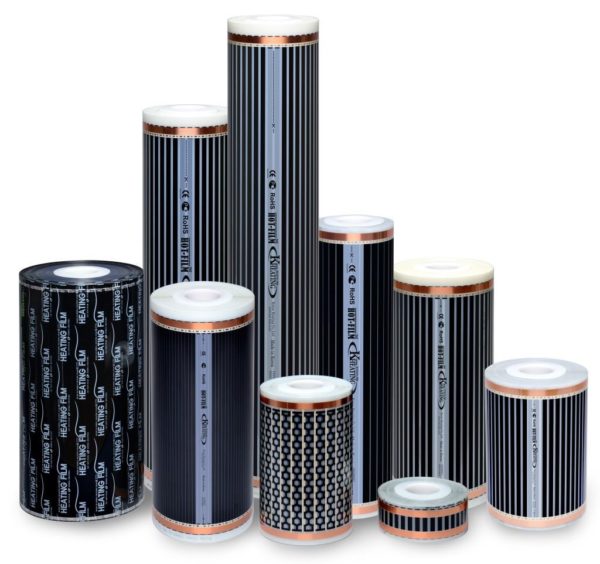

Infrared floor heating
pros
- high heating rate of the floor covering;
- due to its flexibility, the film can be installed on bases of any shape, including steps;
- when using a warm floor, the risk of harm to human health is excluded;
- the system continues to work even if some part of it is damaged;
- the film is easily cut if necessary;
- the subtlety of the warm floor allows it to be used in any room;
- the service life of the warm floor is 2-3 decades.
Minuses
- If the film is laid under varnished parquet, the temperature on its surface should not exceed 21 degrees Celsius, otherwise deformations of the facing are possible.
- The disadvantage of infrared underfloor heating is some limitation on the permissible pressure. In this regard, the film should not be placed where massive interior items will later be installed.
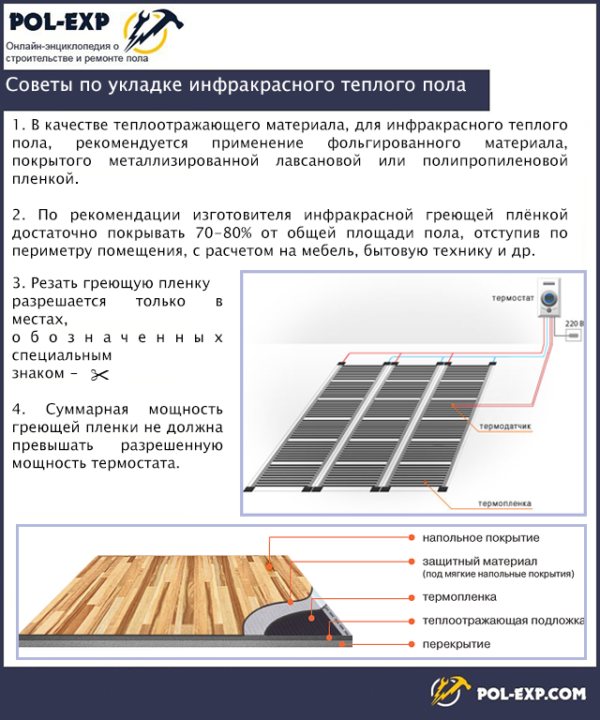

Tips for installing infrared floor heating
Infrared floor heating prices
infrared warm floor
Cable
The floor-standing electrical system is in great demand today among the consumer. A special heat cable acts as a heating element in it. but laying parquet on a warm floor this kind is carried out quite rarely.
pros
- affordable price;
- long service life;
- setting and maintaining the desired temperature;
- easy installation.
Minuses
- heavy load on the wooden floor;
- significant electricity consumption;
- the complexity of repair work in the event of system breakdowns.
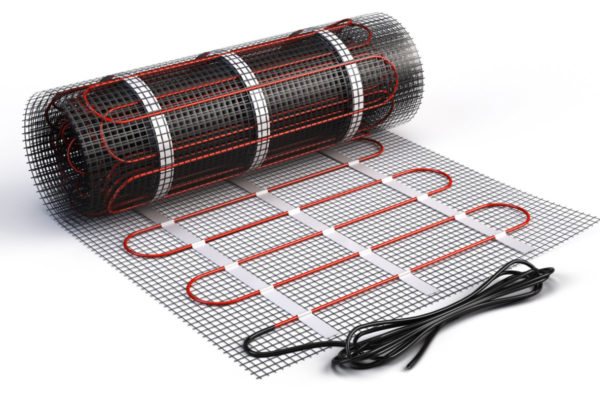

Cable floor electrical system
Prices for cable underfloor heating
cable underfloor heating
Water
Such heating systems are installed just as often. It consists of flexible plastic pipes filled with water supplied from a boiler or central water supply. How does it work water heat-insulated floor under parquet board: when the heating is turned on, the liquid heats up, but the temperature rises gradually. As a result, sharp temperature drops, leading to deformations of wood, are excluded. But the installation of a water-heated floor is laborious.
pros
- even distribution of heat;
- saving energy consumption;
- does not dry indoor air.
Minuses
- labor intensity of installation;
- high initial costs;
- the likelihood of a leak and the complexity of its elimination;
- cannot be installed in apartments.
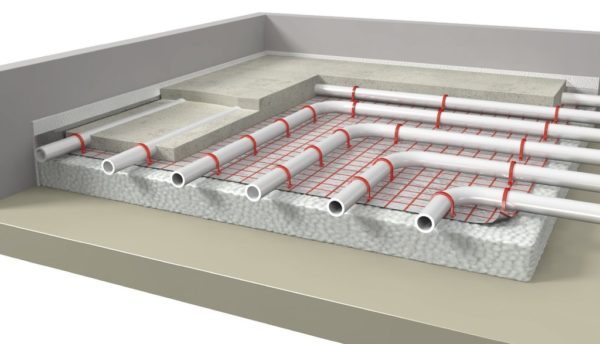

Water underfloor heating device
Deciding which warm floor is better for a parquet board, it must be borne in mind that both cable and water-heated floors are filled with a concrete screed, which protects the system from damage and increases the efficiency of its operation. In this regard, any shortcomings made in the work can affect the functioning of the entire heating. In the case of using an infrared warm floor, the screed is not poured. It can only be used as a base for placing the film.
Prices for water heat-insulated floor
water heated floor
All of the above heating systems work according to the same principle: at the first stage, the floor covering is heated. Already from it, heat energy is distributed throughout the room.
Features of heating such a floor
To summarize, there is only one feature - caution. The maximum water temperature should not exceed 50 degrees
But the lower surface of the tree should not heat up by more than 40 degrees.
The above parameters are very easily controlled by the equipment that is part of the heated floor, and, on the contrary, in a situation of heating with electricity, it is very difficult to adhere to them. Therefore, parquet flooring is better suited for a water-based floor heating system.
Experts studying parquet flooring have long noticed that under more or less traditional conditions of our climate in winter, gaps between parquet floorboards will be clearly visible, which will disappear in warm summer. This is also the result of temperature fluctuations, from which the humidity indicators are subject to fluctuations.
If you want to minimize gaps, it is worth laying planks with a minimum width.
Answering the question about the advisability of using parquet for warm water floors, let's say that it is quite possible and even effective. If you adhere to certain rules, everything will turn out in the best way.
Laying parquet on underfloor heating all pros and cons
Professional builders-finishers still cannot come to a consensus on whether a warm floor under a parquet board is an acceptable option.
Each side has its own compelling pros and cons of laying natural wood flooring on a warm floor.
"Vs"
First, consider the arguments of those who are categorically against the use of parquet boards for underfloor heating.
- Poor thermal conductivity. Due to the fact that natural wood has a low coefficient of thermal conductivity, the transfer of thermal energy from heating elements to the air of the room will be significantly hampered. Accordingly, underfloor heating will lose one of their main advantages: higher efficiency compared to wall-mounted radiators. To maintain a comfortable room temperature, you will have to heat up electrical wires or heat transfer fluid to higher temperatures. The economy and efficiency of ultra-modern underfloor heating will eventually become on a par with the "classics" of a century ago - suspended heating radiators. The underlay for the parquet board, which is an integral element in the installation of the floor covering, will only aggravate the situation.
With regular exposure to high temperatures, the tree can deform
The next argument against is related to the performance characteristics of natural wood. Using a parquet board as a conductor of thermal energy can adversely affect its condition. Under the influence of regular temperature changes, even a well-mounted coating can soon acquire an unpresentable look. Dry, creaking floorboards, cracks and deformation of wood, peeling varnish are possible consequences of exposure to high temperatures. For a warm water floor, there is another argument against laying parquet boards on top of it. It's all about the coolant circulating through the plastic pipes. Despite the long-term warranties from manufacturers of water floors, there is the potential for water breakthroughs or leaks. As a result of such, even purely hypothetical, accidents, your expensive flooring may become unusable: the fungus and rot that multiply under it will quickly do their job. For more information on using parquet flooring on warm floors, see this video:
However, in spite of everything, a number of experts consider the flooring of a parquet board over underfloor heating quite acceptable. To do this, you should only follow certain rules and recommendations.
- Uniform heating of the entire surface of the floor covering. The ideal option for combining parquet and underfloor heating without conflict is IR heating elements. Infrared underfloor heating under the parquet board ensures the most even heating of all floorboards. As a result, the risk of joint cracking or deformation of the wood is minimized.
- You should not buy parquet boards made of natural maple and beech for flooring on warm floors. Their wood is very sensitive to temperature changes, which causes its deformation and cracking.
- The optimum thickness of the parquet board is 12 mm. Thinner options will become unusable too quickly under the influence of temperature changes, and too thick parquet will create an unnecessary obstacle to heat circulation.
- Along the perimeter of the walls at the level of the flooring, fix the damper tape. It will play the role of a shock absorber during compression-expansion of parquet under the influence of temperature differences. For the same purpose, parquet should be laid in a “floating” version without a rigid bond with the base of the floors.
- Recently, special varieties have appeared on the construction market, combined with floor heating systems. They are individually labeled, as well as recommendations for their mode of operation.
In no case should self-tapping screws and dowel-nails be used: the likelihood of damage to the water pipes poured into the screed or the power cable is too high. For more information on laying parquet on a film floor, see this video:
Having become familiar with the features of parquet flooring and floor heating systems, each owner can independently weigh the pros and cons, choosing the option that suits him the most.
Why is laying parquet on a warm floor not effective?
Parquet flooring itself is a very warm material, but many users want additional heating by installing a warm floor system. These two ratios will not always give a positive result. The following factors are the reason for this incompatibility:
- The parquet is made of wood, which is an excellent insulator that prevents the penetration of heat from the heating elements of the underfloor heating.
- Lamellas made from natural raw materials are highly sensitive to high temperatures and high humidity. Under the influence of these factors, boards can crack and lose their original appearance.
- Self-tapping screws are often used to fasten the parquet board. It is with their help that the plywood substrate is installed. It is almost impossible to lay the flooring without the participation of these fasteners, but they can damage pipes, electrical cables or a film with a circulating coolant. This can lead to failure of the entire underfloor heating system.
Installation of a water floor
A water floor is a good solution and is often made when a wooden floor needs to be laid. Thanks to this, the room is heated without problems, and an additional heating system is not required. Advantages of systems of this type:
- the minimum amount of electricity is consumed;
- they are safe and environmentally friendly;
- the base heats up evenly.


However, water heating elements also have their drawbacks. You should also learn more about them:
- temperature control is much easier than infrared or electric floors;
- in the process of laying plastic pipes, the floor level rises by 10 cm;
- when laying a water floor, it is impossible to completely eliminate leaks;
Due to the disadvantages that a water floor has, it should not be installed in apartments in multi-storey buildings. If a leak occurs, several problems arise - the coating material will warp and the wiring will short out.


Underfloor heating systems
To figure out how compatible a warm floor and a parquet board are, you should take a closer look at their design and operational features.
Floor heating attracts, first of all, by the possibility of uniform heating of the room.Unlike classic wall-mounted heating radiators, underfloor heating creates the most comfortable temperature in the lower half of the room, that is, in the area where residents are usually located.
In the case of wall-mounted radiators, the air heated by them first rises to the ceiling, and only then begins to spread to the bottom. In this regard, the efficiency of floor heating systems is much higher.
Today, there are three main types of underfloor heating on sale:
Each of these systems has its own characteristics, advantages and disadvantages.
Water floors
In this case, a heated coolant serves as a heat source. The entire heating structure consists of a hot water boiler, from which the coolant is supplied by circulating sediment to a system of pipes laid under the floor covering.
Most often, flexible plastic acts as a material for pipes. Such pipes, unlike metal ones, are easily deformed under external influence, which can create obstacles for the normal circulation of the coolant.
Therefore, after installation, the water floors are filled with a cement screed, which plays not only the role of protection from external physical influences, but also a heat conductor.
Cable and infrared foil floors
This type of underfloor heating uses electricity as a source of thermal energy. True, there are significant differences in their design and operation.
Cable floors are electrical wires enclosed in an insulating sheath and which, under the influence of current, begin to heat up. From them, heat is transferred to the surrounding objects, primarily the floor covering.
Cable floors, for the same reasons as water floors, are poured into a concrete screed, which serves as "armor" and increases the efficiency of the heating system.
Film floors are also powered by electricity, but infrared radiation is used to transfer heat. Special graphite heating elements enclosed in a protective film convert electricity into infrared radiation. By means of infrared rays, the heat from the foil floors is transferred to the surrounding surfaces.
Due to this feature of operation, infrared floors are not enclosed in a concrete screed. In this case, it can only be used as a leveling base.
As you can see, all floor heating systems, regardless of their design features, have one main thing in common: the floor covering is initially heated, from which thermal energy is transferred to the surrounding air.
In this context, the compatibility of parquet and underfloor heating should be analyzed.
What kind of warm floor to choose for parquet and parquet board
Water heating
This system is a network of polymer pipes through which hot water circulates from a boiler or central water supply system. A screed is poured on top, on top of which the finishing coating is laid. It is a contact heating system, i.e. the coolant, passing along the heating circuit, gives up its heat to the screed, which in turn heats the floor covering. This system is rather complicated and expensive to install. In the event of a failure, locating and rectifying the failure is not an easy task. The use of such a system in apartment buildings is prohibited (clause 11.9 of the Decree of the Moscow Government No. 508-PP of 10/25/2011).
Why wood flooring is not suitable for heated floors
There is no worse coverage for warm floors than natural wood. Whichever side you look at, this solution has some drawbacks. Let's consider the problem from two points of view: heating and decoration.
Heating problem
The whole structure of a warm floor in a room: pipes with a coolant circulating through them, a concrete screed or a rack or floor system that replaces it and a covering - this is one large heating device
It is important for the heater that the maximum possible part of the thermal energy enters the room without encountering obstacles in its path. The cast-iron battery transfers heat to the environment without any problems
Also, the warm floor, where the pipes are filled with a layer of concrete about 4 cm thick, and ceramic tiles are laid on top, gives off heat energy well to the room. This is because metal, concrete and ceramics have high thermal conductivity.
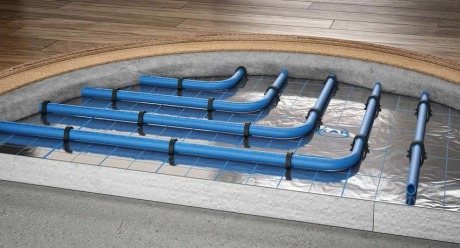

An experiment can be carried out: in winter, wrap the radiator located in the room under the window in a warm blanket. After a while, we will feel that the room has become noticeably colder. The blanket prevents heat transfer, the coolant returns to the system at almost the same temperature that entered the battery. If we wrap all the radiators in the house in blankets, the rooms will become cold, and the boiler may overheat.
Natural wood has low heat transfer and works like a blanket, reducing heating efficiency. In addition, thermal energy, meeting an obstacle to its distribution from above, will tend downward, into the ceiling or sub-base of the floor. In order not to lose a significant part of the heat, you will have to additionally insulate the floor structure from below. And this is financial costs and a decrease in the height of the room due to an increase in the thickness of the insulation. The above indicates that it is not economically feasible to use a natural wood covering for underfloor heating.
Coating problem
Natural wood is a "living" finishing material. Wood fibers easily pick up and release moisture, while the geometric dimensions of the products change noticeably. Wet wood swells, when moisture is lost, it shrinks, the changes are especially large across the fibers. The relative humidity in the room in summer is 40-65%, at these values, wooden furniture and floors "feel" well. During the heating season, with radiator heating and the absence of humidifiers, humidity can drop to 20-35% and below. At the same time, the wooden floors dry up: gaps appear between the parquet floors and the closer to the batteries, the wider the gaps in the floor. Imagine that the entire floor is a large radiator that constantly heats the entire surface of the wooden floor. Under the influence of heat, the wood will dry out, the parquet floors or boards will decrease in size and noticeable gaps will appear between them throughout the entire area of the coating. The higher the temperature of the heated floor, the more the wood will dry out during the winter.


A multilayer parquet board will behave a little more stably. Due to the fact that it consists of several layers of wood, the fibers of which are located perpendicularly, the moisture-temperature deformations of the glued parquet board are not as great as those of massive parquet and floorboard.
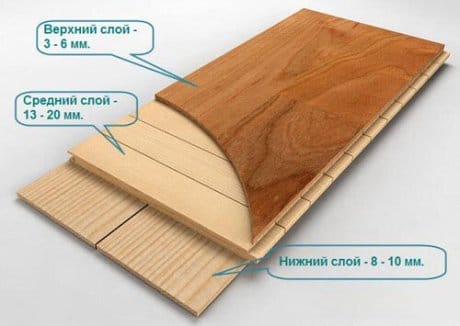

But here the consumer faces a different danger. In the manufacture of parquet boards, glue containing formaldehyde is used. Up to a temperature of 26 ºC, it is bonded in glue and the parquet board is safe. When the specified temperature is exceeded, harmful formaldehyde vapors begin to be released and enter the air. At the same time, the operating temperature of the coolant in the heated water floor system, which is provided by standard equipment, is 40ºC. The floor surface can be heated up to 35 ºC.
What is a parquet board
Parquet board is a relatively new type of flooring used as an alternative to parquet.
This type of board has a number of the following advantages:
- environmental friendliness, the composition includes natural wood;
- convenience during installation / dismantling, the board is sold already processed and no additional preparation of the material is required before installation, which saves time spent on installation, and a convenient lock connection simplifies the laying technology;
- if necessary, the flooring of parquet boards can be easily dismantled without damaging the material itself; after dismantling, the parquet board can be reused;
- the possibility of operation immediately after installation, after the covering of parquet boards has been installed, it can be used immediately because it does not require additional work - coating with oil, varnish, etc .;
- price, the relatively low price can be attributed to the advantages of this material;
- presentable appearance, thanks to the presentable appearance, the parquet board will look favorably in any room;
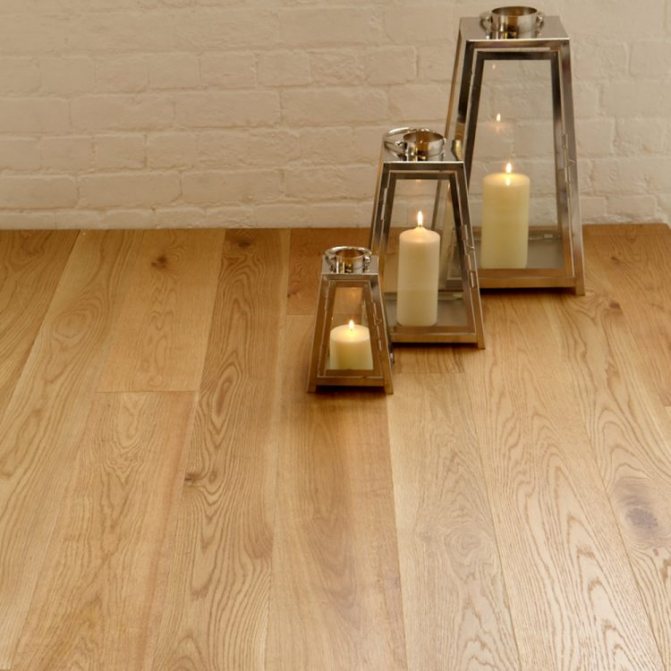

But besides the advantages, this material also has disadvantages, which are important to consider:
reduced moisture resistance, this material does not differ in moisture resistance - therefore, when carrying out installation work, special attention must be paid to protection from moisture; a claim for stratification of the material, during improper operation or installation there is a risk of stratification of the material, which, of course, will negatively affect the appearance of the coating and the room as a whole; increased requirements for the base surface, a prerequisite for laying parquet boards is a perfectly flat surface.
Advantages and disadvantages of the material
A good host strives to improve his home and chooses aesthetic and functional finishing materials. The advantages of a parquet board include:
- respectable type of natural wood of valuable varieties;
- quick and convenient installation due to the locking system for fastening ready-made elements;
- no need for additional surface treatment (finished flooring does not need to be varnished, oiled, etc.); relatively low price.
The parquet board also has disadvantages that should be taken into account when choosing it for finishing a warm floor. These include:
- low moisture resistance - water can cause irreparable damage to the coating;
- risk of delamination due to installation errors or improper operation;
- high requirements for the surface on which the flooring is laid - it must be absolutely flat and clean.
Primary requirements
If it was decided to lay a wooden covering on a warm floor, then, in order to avoid possible problems, the following number of features of such a combination should be taken into account:
- The most suitable type of parquet for laying on a warm floor is parquet board, since this floor covering is better than others capable of withstanding changes in humidity and temperature.
- In order for the board not to dry out too much when heated, its factory humidity should not be higher than 6..7%.
- It is best to choose a board with the smallest plank width as possible, because the size of the gap, all other things being equal, is directly proportional to the transverse dimension of the plank.
- Parquet boards on a warm water floor should be installed either by professionals, or at least under their direct control.
- The maximum permissible temperature of the parquet surface is 26 ° C, and it is strictly not recommended to exceed it. Any excess can cause drying and deformation of the planks of the parquet board.
- Any change in floor temperature during operation should be gradual.
- When using a warm water floor system, a waterproofing layer should be installed.
- When choosing a parquet board, you should focus on the one that is made from deformation-resistant wood. The most commonly used wood is oak. At the same time, maple or beech wood is the most undesirable choice, since it is these species that are most sensitive to changes in moisture levels.
- In order to prevent the humidity level from falling below 40%, a humidifier should be used.


laying parquet boards on a warm floor
Why it is not advised to mount a parquet board on a warm floor
Floor coverings made of natural wood, which include parquet, tend to deform when exposed to and temperature changes, to dry out. In addition, at high heating, substances harmful to human health can be released.
Another feature of wood flooring is low thermal conductivity, which depends on the type of wood.
The worst option in this regard is cork, the best is oak. The structure of the parquet board has a layered character. Therefore, the plank contains several types of wood at once. On average, the thermal conductivity of parquet is 150 mW / m * K.
The deformation of the material and the release of toxic compounds when heated, in addition, low thermal conductivity - all this indicates the impossibility of laying parquet floors on a heated surface. However, if you wish, you can bypass these points.
It is necessary to decide on the choice of a system of underfloor heating, choose a substrate material, and the parquet itself. Let's consider each of the points separately.
The temperature of the floor covering should not exceed 26 ° C to prevent the release of formaldehyde vapors into the air. At the same time, the temperature difference between the parquet and the room should not exceed 2 ° C in order to avoid additional temperature stresses.
Choosing a warm floor for a parquet board
Without going into particular details related to the organization of heating using electric cables or pipes with hot water as a heat carrier, we only note that both options have found application in repair and construction and design solutions.
At the same time, the organization of electric heating is cheaper in terms of work and materials, while water heating can use different types of fuel and is cheaper to operate.
Electric heating is more often used to solve local problems in separate rooms, and hot water is mainly used to heat houses with their own heating system or to heat large objects.
As a rule, underfloor heating systems are used to heat cold floor coverings: tiles, porcelain stoneware, laminate, linoleum. However, if you decide to use parquet or solid oak flooring, check out the following guidelines. As you know, wood does not have thermal conductivity and, by laying parquet or plank on a warm floor, you reduce the efficiency of the heating system.
As a possible option - installation of plywood on two-component polyurethane glue. When using it, you can do without self-tapping screws. But this will not prevent your parquet from drying out. If you nevertheless decide to lay parquet or solid plank on heated floors, then it is desirable that the wood flooring at the time of installation has a moisture content of 8 + _2%. It is recommended to use the most stable wood species with a close-to-radial cut.
It is advisable to use oil as a topcoat on heated floors. It does not break the coating layer when the dies move, has a higher permissible operating temperature on heated floors. The oil has a wide range of colors for tinting floors, provides the possibility of local repair and faster, compared to varnish, complete renewal of the top layer.
If the finishing of parquet or decking is carried out under production conditions, the use of oil is less laborious and requires less time. The use of parquet flooring with bevels and factory-applied oil coating will allow, avoiding grinding and applying oil on the site, to reduce the time spent on work.In this case, it becomes possible to apply oil to the end sides of the laying elements, which provides increased moisture protection of the parquet during operation, including in the presence of gaps between the planks.
The lower wear resistance of oil coatings will require more painstaking and frequent maintenance and reapplication, which, at the same time, is not a particularly difficult and expensive factor.
Warm floor under parquet and parquet board
Parquet is a floor covering with a thickness of 15 to 22 mm, made entirely of natural wood. Parquet is not a finished product, therefore it is sanded and varnished after installation. With careful use, the average service life of block parquet is more than 50 years.
Parquet board is a wooden floor covering made by gluing several layers of wooden planks. The bottom layer is stabilizing, made of softwood. The middle bearing layer is also made of softwood. The top layer is decorative, made of valuable wood. From above, the parquet board is protected with varnish or impregnated with oil. The total thickness of the parquet board is 14 mm, while the thickness of the top layer does not exceed 4 mm. The average service life of a parquet board, subject to operating rules and renewing the varnish every 4-5 years, is 15-20 years.
Parquet board for underfloor heating
Externally, and in the way of assembly, parquet is similar to laminate and engineered board, but in quality and characteristics it is significantly different.
Parquet is a multi-layer covering, which consists of the following layers:
- decorative - wood covered with at least 3 layers of varnish;
- medium - made from coniferous wood, and serves as a flavoring;
- bottom - made of coniferous veneer, gives strength.
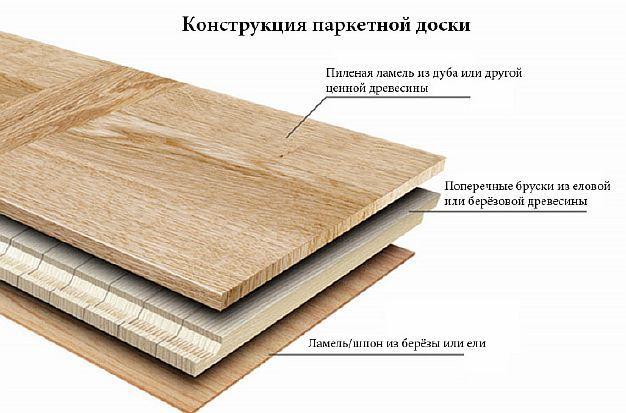

Parquet boards are durable and warm in themselves. The strength of the parquet is influenced by the wood from which the top layer is made. It is he who is primarily affected by temperature. The most durable board is oak.
Parquet is divided according to the cutting method: radial and tangential... Parquet made by the first method is of higher quality, resistant to deformation, looks better externally, but also at a higher price. It can be determined by the presence of annual rings.
There are several types of parquet:
- Single-piece - represents dies, the length of which ranges from 40 to 200 mm, width from 40 to 70, thickness from 14 to 22 mm. An important parameter affecting durability is the thickness of the working layer.
- Massive - board length 2 - 2.5 m, width - 120 - 200 mm, thickness - 18 - 22 mm.
- Shield - multilayer slab (backing and front layer). In the manufacture of the substrate, less valuable rocks are used, and the front side is made of more expensive ones. This model is usually square, with dimensions of 400 x 800, and a thickness of 20 - 40 mm.
All models are grooved for easy installation.
Today, in the world there are a large number of companies engaged in the production of parquet products. The leading place is given to such as: TARKETT (Serbia), UPOFLOOR (Finland), ABERHOF (Germany), AMBER-WOOD (Russia). In our country, products have gained particular popularity. The average cost ranges from 1,700 to 10,000 rubles.

